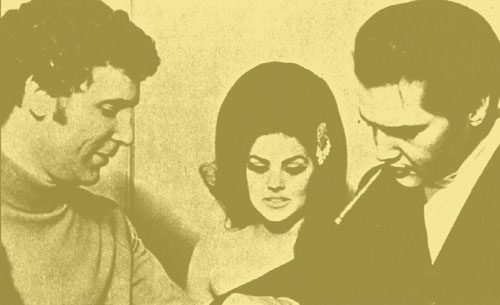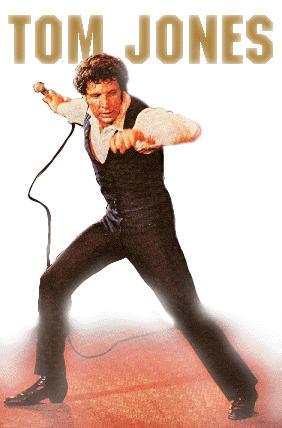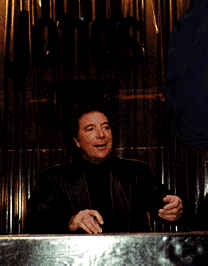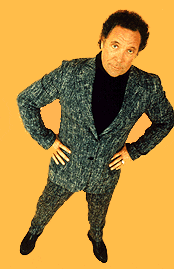
(please note that I didn't write the information on this page - it was collected from a wide variety
of web sources several years ago, and I don't have links to the original sources.)

(please note that I didn't write the information on this page -
it was collected from a wide variety
of web sources several years ago, and I don't have links to the original
sources.)
| In his native Wales, he is known as "Jones the Voice". Today, he is one of the enduring personalities in the music entertainment business. His unique vocal power, ability, and charismatic persona make him one of the most respected, admired and loved performers in modern music. |
|
Tom's unique weighty voice is a baritone to tenor range. He is a vocal powerhouse with the ability to give his audience every ounce of his energy, enthusiasm and concentration. If his delivery is vigorous, he invites his audience in with the vulnerability of his emotional conviction. He is a natural, a Welshman, a worker, an artist.

Tom has a fundamental interest in a wide range of musical expression. He is first and foremost a rocker with a true rhythm and blues soul. In his youth, he was a "Teddy-Boy", a rebel, with not much on his mind but music and sex. His young style and attitude was dominated by the birth of rock 'n' roll. But he had ears and a natural ability that could appreciate and understand the quickly burgeoning styles of popular music. As much time as he spent listening to American and British radio he would spend in the pubs, drinking and singing. He learned he could sing anything, and he learned he could entertain.
Tom has sustained his popularity for more than three decades. His recordings have spanned the spectrum from pop and rock to standards, rhythm and blues to rockabilly, country to dance and contemporary urban sounds.
Born Thomas Jones Woodward in Pontypridd, South Wales, Great Britain on June 7, 1940, his father worked the coal mines of the Rhondda Valley, while his mother tended the house and the two children. The old great Welsh traditions of poetry and song were the love of the laborers - born of their earth, the life of their gatherings, the soul of their hard lives.
Tom was singing at an early age. He sang in the church and with the choir at the Treforrest Secondary Modern School. He would ask his mother to "pull the drapes and announce me", as he sang on his "stage" in the sitting room. A more or less unsuccessful school career ended, as it did for most boys at age 16, with a wife and son to follow at age 17.
Tom brought in money for his new family from an assortment of
jobs, including a builder's laborer, a glove cutter, paper miller, and door-to-door vacuum
salesman. He sang in the pubs at night, working with local groups. By 1963, he had gained
notoriety with his own group, Tommy Scott and the Senators, and was playing regularly in
the demanding atmosphere of the working-class clubs and dance halls. Gordon Mills, a man
with a solid performance background who had decided to branch into songwriting and
management, went to see Tom work. As Mills recalled: "The first few bars were all I
needed to hear, they convinced me that here was a voice that could make him the greatest
singer in the world."

Mills became his manager, and took him to London to promote him. It was not an easy task, as record companies found him disconcerting. The vocal sound was raucous and too powerful, the performance style too forward and sexual. He sounded black and moved like Presley. The two men persisted though, and in late 1964 landed a record contract with Decca Records. The first single was not a great success, but the next choice, a new song penned by Mills called It's Not Unusual, was a huge international hit. Considered "too hot" by the established BBC Radio at the time, it was broken by the pirate off-shore station Radio Caroline. By the next year, Tom found himself opening for the Rolling Stones at London's Beat City and gigging with the Spencer Davis Group. Just some of the huge single hits to follow were What's New Pussycat, Help Yourself, Never Fall In Love Again and Without Love.
The next few years of recording success found Tom performing a remarkably varied repertoire, cultivating his natural abilities by listening and learning from his favorite artists of the time. His early performance inspiration came from Solomon Burke, Tennessee Ernie Ford, Little Richard, Jackie Wilson, Brook Benton, Big Bill Broonsy and many other Blues and R&B greats. The soul of Rock 'n' Roll he found in Jerry Lee Lewis. A long friendship with Elvis Presley was built on mutual respect and admiration. Elvis would warm up his voice to Delilah before his own performances, and when Green Green Grass of Home hit for Tom in 1966, Elvis would call radio stations repeatedly to request the song.
An avalanche of gold singles and albums were soon to follow: Delilah, Help Yourself, Love Me Tonight, and I'll Never Fall in Love Again in 1968, Funny Familiar Forgotten Feelings, and LP's Tom Jones Live, Tom Jones in Las Vegas, and This is Tom Jones in 1969. For most of the year, several of the LPs were in the Top 10 Charts in both Europe and the United States.
Continuing into the 70s gold hits came with I (Who Have Nothing), She's A Lady and Tom Jones Live at Caesars Palace. By the end of 1970 Tom had sold over 30 million discs in all categories around the world.
With this tremendous recording success, Tom was able to draw
capacity audiences everywhere in concert halls and arenas worldwide. His skills as a
singer developed sharply; his energy, openness and spontaneity appealed to critics and
audiences alike.

Tom was offered his own television show the summer of 1969. A contract was drawn with ABC that was the largest ever between network and artist. The show's location was split between London and Los Angeles, and included an impressive roster largely suggested by Tom: Aretha Franklin, Elvis and Priscilla Presley, Stevie Wonder, June and Johnny Cash, Charlie Pride, Bob Hope, Jerry Lee Lewis, The Who, Janis Joplin, Richard Pryor, Roy Clark, Sammy Davis Jr., Paul Anka, Ray Charles, Lou Rawls, Tony Bennett, Crosby, Stills, Nash and Young, George Carlin, Little Richard, Bee Gee's, Sonny & Cher, Wilson Picket, The Hollies, Smokey Robinson, The Supremes and Joe Cocker & The Grease band were but a few of the guests involved. Tom has always been a champion of the collaboration, interested in the fusion of talents and styles.
In 1987, Tom was asked to perform a musical play with a bullfighting theme called Matador on the CBS Epic label. The single, A Boy From Nowhere, reached #2 on the British charts that summer. This prompted insistent requests for It's Not Unusual in the London clubs along with a very successful re-release of the song in the charts. A new interest in Tom Jones emerged amongst a whole new generation of fans.
Late in 1988, the British avant-garde techno-pop group The Art of Noise requested a collaboration with Tom on a cover of Prince's Kiss. The results were sensational and highly contemporary, and the record put Tom back into the Top 10 charts in Europe and the Top 40 in America. The video of Kiss was seen in strong rotation on both MTV and VH-1, winning the "Breakthrough Video" MTV Award that year. Tom Jones was once again seen in a format reaching across all demographics worldwide.
In 1991, Tom recorded an album for Chrysalis Records, U.K. The
project, entitled Carrying a Torch is highlighted by a collaboration with an old friend,
Van Morrison. Van wrote, produced and played four songs, while his band provided the
backup. The songs were recorded live in one afternoon and although not released in
America, this collaboration was acclaimed by critics and audiences as an interesting and
successful blend of unique talents.

1991 also saw Tom involved in a number of high-quality projects in the U.K. including two benefits, The Simple Truth and the 30th Anniversary of Amnesty International, aired in the States on MTV. Backed at both events by members of Pink Floyd, Tom was in the company of Paul Simon, Whitney Houston, Sinead O'Connor, Gloria Estefan, Lisa Stansfield, Seal and many more. Towards the end of the year, Tom was asked to participate in The Ghosts of Oxford Street, a new Christmas production conceived and directed by legendary punk impressario Malcolm Maclaren. Tom was cast alongside Sinead O'Connor, Happy Mondays, Kirsty McColl and The Pogues. He sang two songs within the context of the story, including Nobody Knows You When You're Down And Out produced by Dave Stewart.
1992 was an exciting year for Tom. His new six-part television series, Tom Jones: THE RIGHT TIME, produced for the national independent ITV network in the U.K., aired in the summer to wide critical and commercial appeal. The six half-hour segments are music-based and designed in a way unique to television formats. Guest artists include: The Chieftains, Joe Cocker, EMF, Erasure, Bob Geldof, David Gilmore, Daryl Hall, Al Jarreau, Cyndi Lauper, Lyle Lovett, Mica Paris, Sam Moore, Shakespears Sister, Curtis Steiger and Stevie Wonder. The series aired in the U.S. on VH-1.
Following production of THE RIGHT TIME, Tom accepted an invitation to perform as the "special guest" at the Glastonbury Festival of Contemporary Performing Arts, in Somerset, England. Now in its twenty-second year, it is the largest festival in Europe, with four stages that showcase contemporary, alternative, jazz and world-music artists as well as performers of other medium. Tom stunned an audience of 75,000 at sundown, giving perhaps the watershed performance of his latter career.
In November 1992, Tom appeared as himself on the animated hit comedy show The Simpsons. As Marge temporarily finds work at the plant, her boss kidnaps Tom in a plot to seduce her. In the end, Homer makes a chivalrous stand for his wife, and Tom serenades the two of them with It's Not Unusual. Finally, the year closed with a truly special experience: participation in a live stage performance of Dylan Thomas' Under Milkwood, directed by Sir Anthony Hopkins, in aid of The Prince's Trust and performed in the presence of HRH.
Tom began 1993 with a recorded version of the Rolling Stones' classic Gimme Shelter with alternative band New Model Army, released on the independent label Food Records (EMI) in March. The song is part of a multi-record project that will benefit the national U.K. charity Shelter, which has long worked for the homeless.
Shortly after some promotional efforts in support of THE RIGHT
TIME, Tom was invited by Sting and Trudie Styler to participate in an annual show at
Carnegie Hall to benefit their charity, the Rainforest Foundation. In an evening of
extraordinary performances, he shared the bill with James Taylor, George Michael, Sting,
Bryan Adams, Herb Alpert, and Tina Turner. Tom was the surprise sensation of the evening,
ripping through several songs with Sting and his band.

In 1994, Tom signed with hot upstart label Interscope Records (Atlantic/WEA), headed by multi-platinum producer Jimmy Iovine. Interscope's diverse roster includes Nine Inch Nails, Helmet, Pop Will Eat Itself, Dr. Dre, Bush and Snoop Doggy Dog. After taking a year to complete the project, Tom's new album is a stunning development of his abilities. The Lead and How to Swing It is produced by some of today's outstanding talents including Trevor Horn, Teddy Riley, Flood and Alan Moulder, Youth and Jeff Lynne. Each producer welcomed the opportunity to interpret Tom's artistry in his own way; the result is a diverse work critically acclaimed as one of the year's best. Once again Tom proves himself a unique artist - one with a history who is able to renew and reactivate himself with new music, one of the few who is able to bridge decades and genres without being forced or affected.
Also in 1994, Paddy Maloney of the seminal Irish band The Chieftains approached Tom to contribute to their new collaborative project, The Long Black Veil. The song requested was The Tennessee Waltz, which was recorded in a fun-filled afternoon at the late Frank Zappa's studio, Utility Muffin Research Kitchen on Los Angeles. Tom's full-throated Celtic version of the country great is among other contributions from Sinead O'Connor, Sting, Mick Jagger, Ry Cooder, Mark Knopfler, Van Morrison, Marianne Faithful and The Rolling Stones. The skillful musical framework provided by the Chieftains brings out the best in their singers while illustrating once again the deep ties between contemporary sounds and Celtic/American roots music.
Tom enjoys a consistent U.S. and international touring schedule throughout the year. He lives with his wife of 38 years, Melinda, in their homes in Bel Air, CA and South Wales. His son Mark, and daughter-in-law Donna, have given him a grandson Alexander John, born in 1983, and a granddaughter Emma Violet, born in 1987. His mother and sister also live in Los Angeles. Since September of 1986 when Gordon Mills suffered an untimely death, Tom has been managed by his son Mark Woodward, who traveled with him since the age of 17.
Tom Jones continues to both deliver and surprise. His voice has matured to perfection, his performance is as driven as it is seasoned, his persona as bold as it is witty and charming. He is completely devoted to his craft and talent, and hopes only that the quickly changing faces of popular music allow him to grow and be challenged as an artist. This incomparable voice and unique talent will be touching the minds and hearts of music lovers for many years to come.
The following quotes are taken from press published in 1994 and 1995:
"Forever-cool Jones, unlike Tony Bennett and Johnny Cash, hasn't aged gracefully. He's aged invisibly, still belting sensual rockers with the hormonal uppercut of a first kiss. The album swings hard, thanks to Jones' sweaty, soulful and winningly dramatic vocals."
- Edna Gundersen, USA Today
"Treating Tom Jones as if he were camp reinforces the prissy notion that great pop is about authenticity and refuses to acknowledge that good work can come from anywhere. He was full to bursting with the passion of a great fan of pop music, and with the joy and release and gratitude he feels for performing. And he remains rawer than show biz usually allows itself to get. It was as purely pleasurable a show as I've seen in months."
- Charles Taylor, The Boston Phoenix
"The good stuff here is so good, you wonder how you've gotten along without Tom Jones for six years. This may be Jones' first true soul album; the tracks produced by New Jack Singmeister Teddy Riley are as funky as anything by Dr. Dre, and far less negative. While the bravura of this Welsh belter . . . remains, two other qualities are even more prominent now: daring and heart."
- Carlo Wolff, Boston Globe
"[Jones'] rock comeback album's first single, If I Only Knew, starts off with an extended scream that's both bloodcurdling and, of course, sex personified. Vocally he's no pussycat, and Jones goes on to creditably sing the living hell out of every track . . . [He's] a willing, able and appropriate vessel for reinvention, and a brassy tonic for the lately too-cool world of dance music."
- Chris Willman, Los Angeles Times
"Mr. Jones proved himself to be a pop-music interpreter able to transcend kitsch and nostalgia . . . [He] also sang with an unmistakable voice that switched from a throaty baritone to a smooth bedroom whisper, altering his style enough to attract new fans without alienating his old ones."
- Neil Strauss, The New York Times
"Announcing his presence with the kind of noise you might expect to hear from a lion that has just sat on a red-hot poker, Tom Jones is clearly in a mood to take no prisoners on The Lead And How To Swing It. After . . . If I Only Knew, the brilliant hit single . . . the braying boyo bears down with similar energy and good humour on an impressively broad spread of songs and arrangements. When he teams up with Tori Amos . . . you can almost see Jon Bon Jovi and Meat Loaf trembling in their boots. . . . Jones sounds remarkably in touch, on form and as if he's having a ball."
- David Sinclair, The Times (London)
"Tom Jones proved . . . that he's edgy, way cool and a total crowd- pleaser even when the crowd is more accustomed to his labelmates Nine Inch Nails. His new audience wears Doc Martens, not Dr. Scholl's. From songs by Lenny Kravitz to the Black Crowes, Jones showed himself to be an absolutely unique animal: a rock-song stylist. This is not this year's MTV-friendly Sinatra or Tony Bennett. Jones has moved from pop to bona-fide rock, a talent no one thought he had during his decades of singing wimpy love songs to blue hairs."
- Jeffrey Jolson-Colburn, The Hollywood Reporter
"The antithesis of Tony Bennett . . . Tom Jones has sustained his [credibility] - 30 years after It's Not Unusual - by keeping up with what's new, musically, without embarrassing himself. Audience reaction to the super-energetic set was ecstatic, enough so to drown out the high-decibel chattering characteristic of House of Blues audiences."
- Todd Everett, Daily Variety
"Some leather-clad longhair and I danced and screamed like a couple of tipsy housewives on an annual girls' night out. Normally, you'd have to hold a gun to my head to induce this kind of behaviour, but I guess that's the magic of Tom Jones." - Lorraine Ali, Rolling Stone, Request Magazine poll of best live shows in 1994 (Tom Jones at the House of Blues, 10/94)
"This stormy power ballad (I Wanna Get Back With You) makes excellent use of Jones' patented vocal quiver. Listen for wonderfully ethereal harmony by Amos, whose presence fleshes out the track and gives it depth that sets the single apart from the pack. One more good reason to investigate the veteran artist's The Lead And How To Swing It collection."
- Billboard
"In the end, maybe Tom Jones can do what the current flood of alienated pimples 'n' Prozac novels, those endless media 'debates' between disenfranchised Xers and smug baby boomers, cannot. Catch a Jones show . . . and you might agree that he's the best hope for intergenerational mind-meld since Sid Vicious' snarling homage to Sinatra's My Way. [The show] feels like a family reunion where someone spiked the Hawaiian Punch with windowpane acid. But tonight, voice is the drug of choice. . . "
- Gerri Hirshey, US Magazine
 |
 |
|